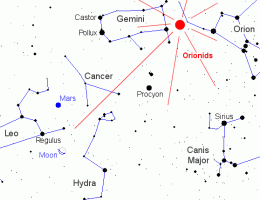Weekend Orionid meteor shower

Earth is about to pass through a stream of debris from Halley's comet, source of the annual Orionid meteor shower. Forecasters expect more than 15 meteors per hour to fly across the sky on Saturday morning, Oct. 22nd, when the shower peaks.
"Although this isn't the biggest meteor shower of the year, it's definitely worth waking up for," says Bill Cooke of the NASA Meteoroid Environment Office. "The setting is dynamite."
Orionids are framed by some of the brightest and most beautiful constellations in the night sky. The meteors emerge from mighty Orion, the shower's glittering namesake. From there they streak through Taurus the Bull, the twins of Gemini, Leo the Lion, and Canis Major--home to Sirius, the most brilliant star of all.
This year, the Moon and Mars are part of the show. They'll form two vertices of a celestial triangle in the eastern sky on Saturday morning while the shower is most active; Regulus is the third vertex. Blue Regulus and red Mars are both approximately of 1st magnitude, so they are easy to see alongside the 35% crescent Moon. Many Orionids will be diving through the triangle in the hours before dawn.
Cooke's team at the Meteoroid Environment Office will be watching for Orionids that actually hit the Moon.
Cometary debris streams like Halley's are so wide, the whole Earth-Moon system fits inside. So when there is a meteor shower on Earth, there's usually one on the Moon, too. Unlike Earth, however, the Moon has no atmosphere to intercept meteoroids. Pieces of debris fall all the way to the surface and explode where they hit. Flashes of light caused by thermal heating of lunar rocks and moondust are so bright, they can sometimes be seen through backyard-class telescopes.
"Since we began our monitoring program in 2005, our group has detected more than 250 lunar meteors," says Cooke. "Some explode with energies exceeding hundreds of pounds of TNT."
So far, they've seen 15 Orionids hitting the Moon--"two in 2007, four in 2008, and nine in 2009," recalls Cooke. This year they hope to add to the haul. About 25% of the Moon's dark terrain will be exposed to Halley's debris stream, giving the team millions of square miles to scan for explosions.
Watching meteoroids hit the Moon is a good way to learn about the structure of comet debris streams and the energy of the particles therein. It also allows Cooke and colleagues to calculate risk factors for astronauts who, someday, will walk on the lunar surface again.
"Going outside to watch the Orionids might not be a good idea for a moonwalker," says Cooke.
But it is a good idea for the rest of us. Set your alarm for a few hours before dawn on Saturday morning and enjoy the show.
Provided by Science@NASA





















